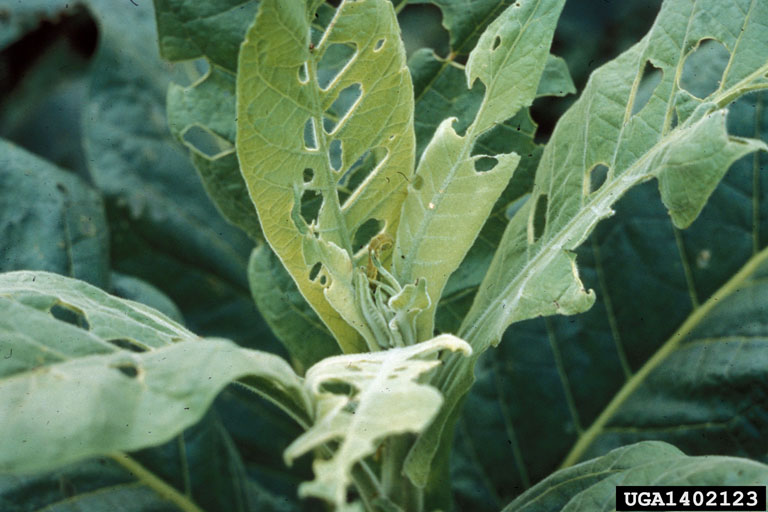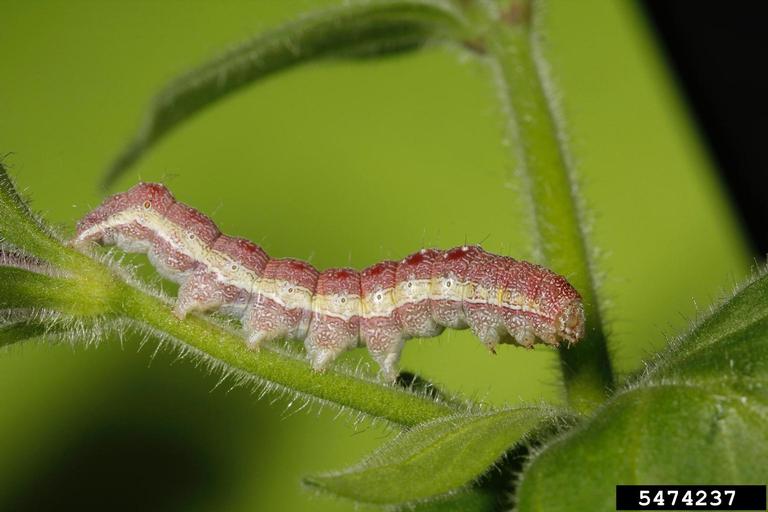
EPPO Alert List – Chloridea virescens (Lepidoptera: Noctuidae)
Tobacco budworm
Why
Chloridea virescens (Lepidoptera: Noctuidae - tobacco budworm), formerly placed in the genus Heliothis, occurs in the Americas where it is a polyphagous pest of many field crops, in particular cotton, maize, tomato, and tobacco (hence its common name). C. virescens was identified in the EPPO Study on Pest Risks Associated with the Import of Tomato Fruit as a potential threat to tomato crops, and recently, the European Union has established measures to prevent its introduction into the EU territory, also considering that it had been intercepted on consignments of fruit and vegetables imported from the Americas.

Damage on tobacco.
R.J. Reynolds Tobacco Company. Bugwood.org

Larvae.
Joseph Berger. Bugwood.org

Adult.
Joseph Berger. Bugwood.org
Where
C. virescens occurs throughout the Eastern and South-Western USA. Generally, it overwinters only in southern states, but it annually migrates towards the north. It is occasionally found in northern US states and southern Canada, surviving in greenhouses or other sheltered locations. It is widespread in the Caribbean and sporadically found in Central and South America.
EPPO region: absent.
North America: Canada (Ontario), Mexico, USA (Alabama, Arizona, Arkansas, California, Colorado, Connecticut, Florida, Georgia, Hawaii, Illinois, Kansas, Kentucky, Louisiana, Maryland, Mississippi, Missouri, Nebraska, New York, North Carolina, Ohio, Oklahoma, Oregon, Pennsylvania, South Carolina, Tennessee, Texas, Virginia, Washington, West Virginia).
Central America and the Caribbean: Barbados, Costa Rica, Cuba, Dominican Republic, El Salvador, Guadeloupe, Haiti, Jamaica, Martinique, Nicaragua, Puerto Rico, Saint Lucia, Trinidad and Tobago, Virgin Islands (US).
South America: Argentina, Bolivia, Brazil (Bahia, Distrito Federal, Espirito Santo, Goias, Mato Grosso, Mato Grosso do Sul, Minas Gerais, Parana, Rio Grande do Sul, Roraima, Sao Paulo), Chile, Colombia, Ecuador, Paraguay, Peru, Uruguay, Venezuela.
On which plants
C. virescens is a highly polyphagous pest (feeding on at least 55 species in 14 families). It is mainly a pest of field crops such as: alfalfa (Medicago sativa), clover (Trifolium spp.), cotton (Gossypium spp.), flax (Linum sativum), soybean (Glycine max), and tobacco (Nicotiana tabacum). It can also attack fruit and vegetables crops (e.g. asparagus (Asparagus officinalis), cabbage (Brassica spp.), melon (Cucumis melo), lettuce (Lactuca sativa), pea (Pisum sativum), cucurbits, tomato (Solanum lycopersicum) and Vitis spp.), as well as ornamentals (e.g. chrysanthemum, gardenia, pelargonium, petunia, verbena, zinnia). A large number of weeds or wild plants have also been reported as larval hosts (e.g. Geranium dissectum, Lonicera japonica, Medicago lupulina, Rumex spp., Sida spinosa).
Damage
Larvae bore into buds and blossoms. Larvae can also feed on tender terminal foliar growth, leaf petioles and stalks, as well as on leaves in the absence of other growing plant tissues. They can also feed on fruit, and attacked fruit may then be more susceptible to secondary infections by pathogens.
Adults are brownish moths, 28 to 35 mm long. In Southern US states, they emerge in spring (March to May). Spherical eggs are deposited on blossoms, fruit, and terminal growth. Females normally produce 300-500 eggs. C. virescens has 5 to 7 instars and fully-grown larvae are 25.5-36 mm long, their body colour is variable from pale green to pinkish, reddish or brownish with whitish dorsal and lateral bands. Pupation takes place in the soil. In the USA, 4 to 5 generations have been observed with an overwintering period (as pupae) starting in autumn (September to November).
Dissemination
Adult moths can fly over long distances. In North America, it has been observed that the pest annually spreads northwards during summer. Over long distances, C. virescens can be transported on plant material. Several EU countries have reported interceptions of C. virescens on imported consignments of fruit and vegetables (e.g. Abelmoschus esculentus, Asparagus officinalis, and Physalis peruviana) from several countries (e.g. Colombia, Dominican Republic, Mexico, and Peru).
Pathways
Fruits and vegetables, plants for planting of host plants, cut flowers, soil, from countries where C. virescens occurs.
Possible risks
Several host plants of C. virescens are economically important crops in the EPPO region (e.g. cotton, maize, tobacco, tomato, ornamentals). According to the EPPO Study on Pest Risks Associated with the Import of Tomato Fruit, the climatic similarity between the areas where the pest occurs and the EPPO region is high. C. virescens probably has the potential to establish outdoors in the Southern part of the EPPO region. It could also be a threat to greenhouse crops. Risk assessment studies (Express-PRA and Quick-scan) carried out by Germany and the Netherlands reached a similar conclusion. At the EU level, it has been considered that although further risk assessment studies were needed, it was necessary to take measures to avoid the introduction of C. virescens in the EU territory (Commission Implementing Regulation (EU) 2022/1941.
Sources
CABI (online) Crop Protection Compendium. Datasheet on Heliothis virescens (tobacco budworm). https://www.cabidigitallibrary.org/doi/full/10.1079/cabicompendium.26774
Commission Implementing Regulation (EU) 2022/1941 of 13 October 2022 on the prohibition of introduction, movement, holding, multiplication or release of certain pests pursuant to Article 30(1) of Regulation (EU) 2016/2031 of the European Parliament and of the Council. OJL 268, 13-15. http://data.europa.eu/eli/reg_impl/2022/1941/oj
Dutch NPPO (2020) Quick scan on Chloridea virescens. 4 pp. https://english.nvwa.nl/documents/plant/plant-health/pest-risk-analysis/documents/quickscan-chloridea-virescens
EPPO (2015) EPPO Technical Document No. 1068, EPPO Study on Pest Risks Associated with the Import of Tomato Fruit. EPPO Paris. /media/uploaded_images/RESOURCES/eppo_publications/td_1068_tomato_study.pdf
JKI (2022) Express PRA zu Chloridea virescens (Express PRA on C. virescens - import for research and breeding purposes). https://pflanzengesundheit.julius-kuehn.de/dokumente/upload/Chloridea-virescens_exprPRA.pdf
University of Florida. Featured Creatures by JL Capinera. Heliothis virescens (revised in 2018). https://entnemdept.ufl.edu/creatures/field/tobacco_budworm (last accessed 2023-01).
Ventura MU, Roberto SR, Hoshino AT, Carvalho MG, Hata FT, Genta W (2015) First record of Heliothis virescens (Lepidoptera: Noctuidae) damaging table grape bunches. Florida Entomologist 98(2), 783-786
EPPO RS 2023/013
